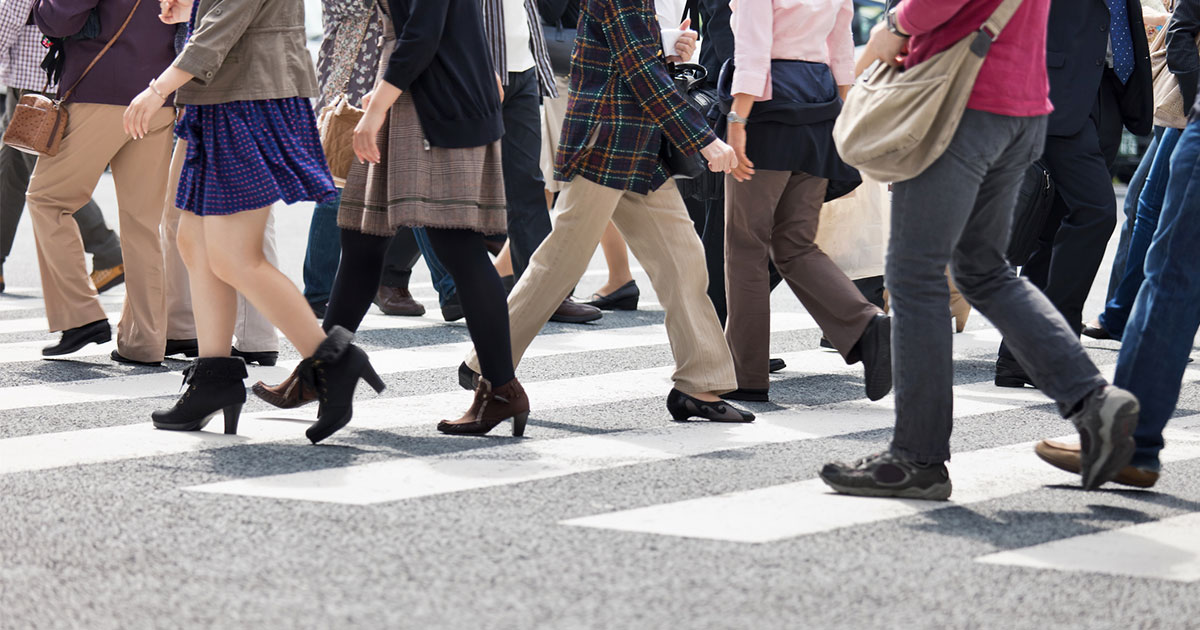Most Americans will have walked 75,000 miles by the time they turn 50.1 A 2014 survey revealed that nearly 8 out of 10 Americans have experienced a foot problem, whether it be an ingrown toenail or chronic foot pain. People who are unable to move about suffer numerous physical, psychological, and social afflictions as a direct or indirect result of foot dysfunction.3 Foot pain affects the daily activities – walking, exercising, or standing for long periods of time. Surveys and research tell us that foot health is intrinsic to overall health, so protecting feet all year long is vital to our overall well-being.1
Being overweight can contribute to foot problems in two ways. First, excess weight contributes to the misery of common structural problems, such as heel pain and arthritis. Any foot ailment is more painful with the more weight you put on it. Secondly, excess weight increases your chances of developing atherosclerosis, poor circulation, and diabetes – all of which can damage your feet. If you deal with foot pain, your healthcare provider may recommend medication or physical therapy for treatment.2
Footwear selection tips
Improperly fitting shoes are the source for many foot complaints and problems. It is important to make an informed decision when shopping for new shoes. Shoes should be comfortable first and foremost. They should fit your feet properly to help prevent injuries, such as blisters and calluses. Shoes should be light-weight and provide good shock-absorption. It is important to look for helpful features, such as Achilles tendon protectors, heel collars, uppers, insoles, midsoles, outsoles, and a toe box to promote maximum comfort. One should consider the shape of their foot, as well as the width and length when buying new shoes to prevent painful conditions, such as hammertoe and bunions. Additionally, one’s arch-type (neutral, high-arched, or low-arched) should be considered to adapt to various surfaces as you walk and to prevent painful conditions, such as plantar fasciitis. It is important to assure that your feet have been properly sized and always walk in the shoes before purchasing them.⁴
When it comes to selecting the proper footwear to keep your feet active, happy, and healthy, follow these recommended techniques when selecting your shoes:1
- Avoid sandal scandals leading to twisted ankles, sprains, instability, pain, and difficulty walking
- Assure good physical balance to avoid falls, especially for elders
- Assure proper measuring of feet prior to purchasing shoes
- Wear the proper sport-specific shoes to improve performance and avoid pain
- Avoid flip-flops that may cause foot pain, if wearing flip-flops assure that there is adequate support
- When choosing footwear for teenagers, assure a proper fit with rapidly growing foot sizes
- Wear running shoes for running exercise
- Wear walking shoes for walking exercise
- Determine which type of shoe is best with your foot type1

Exercises / Stretches
Exercising your feet on a regular basis not only improves overall foot health, but may also reduce your risk for injury. Walking is the best overall foot exercise. When you walk, you put your foot through its full range of motion, from the time your heel hits the ground until you lift off with your toes. Walking is one of the best forms of exercise for your entire body. It improves your cardiovascular health and can help your circulation, muscle tone, and mood.2
In addition to walking, routine flexibility and resistance exercises using weights or exercise bands can also help keep your feet healthy. Exercises that improve flexibility help keep your feet limber and may reduce your risk for injury by strengthening muscles to provide better support and protection for the foot as a whole. Don’t worry if your feet have grown stiff with age; studies show that no matter how old you are, you can still improve your flexibility. The easiest way to build flexibility is through slow and gentle daily stretches, focusing on one group of muscles at a time. Foot exercises should not hurt and it is essential to warm-up and stretch the muscles in your feet before doing any foot exercises.2
Do’s and don’ts of footcare
Remember that bad shoes will cause painful foot conditions, such as corns, calluses, blisters, ingrown toenails, and other sources of irritation. Foot pain should never be considered a normal occurrence. Footcare 101 endorses the following tips:3
- Don’t wear too-tight shoes.
- Don’t share shoes.
- Don’t share pedicure utensils with your pals.
- Don’t hide discolored nails with polish. Let them breathe and treat the underlying issue.
- Don’t shave calluses.
- Don’t perform “DIY surgery” on an ingrown nail. Do cut toenails straight across to prevent ingrown nails.
- Do try the Legs-Up-the-Wall yoga pose after a long day or a hard workout.
- Do give yourself a foot massage or book a reflexology session.
- Do roll a tennis ball under your feet.
- Do soothe irritation with a vinegar foot soak.
- Do wear socks to bed, but assure they are not too tight and constricting.
- Do change your socks daily.3
Seeking care
If you are experiencing frequent foot complaints, pain in your feet, or having trouble finding comfort in your everyday footwear selection, contact your primary care provider to discuss proper foot care and podiatry referral options. It is vital for diabetics and those with poor peripheral circulation to have a detailed foot exam at least once annually. Contact your healthcare provider to discuss proper footcare and to schedule your foot exam today.
©2022HealthSpot References: (1) American Podiatric Medical Association (2020). Tips for healthy feet. Retrieved on 04/29/2020 from https://www.apma.org/Patients/HealthyFeetTipsList.cfm?navItemNumber=31088 (2) Harvard Medical Publishing (2020). Is foot pain slowing you down? Retrieved on 04/29/2020 from https://www.health.harvard.edu/promotions/harvard-health-publications/healthy- feet (3) Healthline (2020). The smart girl’s guide to healthy, happy feet. Retrieved on 04/29/2020 from https://www.healthline.com/health/tips-for-healthy-feet-footwear-hygiene (4) Mayo Clinic (2020). Walking shoes: Features and fit that keep you moving. Retrieved on 04/29/2020 from https://www.mayoclinic.org/healthy-lifestyle/fitness/in-depth/walking/art-20043897.

